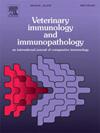Development and Bayesian analysis of a competitive inhibition ELISA for caprine brucellosis
IF 1.4
3区 农林科学
Q4 IMMUNOLOGY
引用次数: 0
Abstract
Caprine brucellosis, caused by Brucella melitensis, is a zoonotic disease responsible for abortions in goats and is endemic in several countries. Control measures include vaccination, serological assays, and culling of infected animals. Sensitive, specific, automatable, and low-cost serological assays are essential for use in endemic regions. This study aimed to develop and validate a competitive inhibition enzyme-linked immunosorbent assay (ciELISA) to detect anti-B. melitensis antibodies in goats. The ciELISA was standardized with pre-dilutions of ISaBmS (1/8 and 1/300) in negative goat serum. Validation was done using 1254 serum samples from non-vaccinated goats: 843 from brucellosis-free flocks and 411 from infected flocks in Argentina. Serum samples were tested with the ciELISA, buffer plate antigen (BPA) test, fluorescence-polarized antigen (FPA) test, and complement fixation test (CFT). The optimal ciELISA cutoff was determined using a receiver operating characteristic (ROC) curve, with CFT as the gold standard. Sensitivity and specificity were evaluated using the Bayesian Latent Class Model (BLCM). The ciELISA showed sensitivity of 98.29 % (95 % CI: 96.4–99.6) and specificity of 98.62 % (95 % CI: 97.6–99.6). The kappa statistic (κ) values between ciELISA and other tests were: BPA (κ = 0.94), FPA (κ = 0.79), and CFT (κ = 0.95). The ciELISA demonstrated excellent performance, being rapid and objective, making it suitable for detecting anti-B. melitensis antibodies in goat serum.
山羊布鲁氏菌病竞争性抑制酶联免疫吸附测定试剂盒的研制及贝叶斯分析
由布鲁氏菌引起的山羊布鲁氏菌病是一种导致山羊流产的人畜共患病,在多个国家流行。控制措施包括接种疫苗、血清学检测和扑杀受感染的动物。灵敏、特异、可自动化且成本低廉的血清学检测方法对流行地区的使用至关重要。本研究旨在开发和验证竞争性抑制酶联免疫吸附试验(ciELISA),以检测山羊体内的抗梅里金牛血清抗体。用阴性山羊血清预稀释 ISaBmS(1/8 和 1/300)对 ciELISA 进行了标准化。使用 1254 份未接种疫苗的山羊血清样本进行了验证:其中 843 份来自阿根廷未感染布鲁氏菌病的羊群,411 份来自受感染的羊群。对血清样本进行了 ciELISA、缓冲板抗原(BPA)检测、荧光偏振抗原(FPA)检测和补体固定检测(CFT)。以补体固定试验为金标准,使用接收器操作特征曲线(ROC)确定了最佳的 ciELISA 临界值。使用贝叶斯潜类模型(BLCM)评估了灵敏度和特异性。ciELISA 的灵敏度为 98.29 %(95 % CI:96.4-99.6),特异性为 98.62 %(95 % CI:97.6-99.6)。ciELISA 与其他检测方法之间的卡帕统计量(κ)值分别为BPA (κ = 0.94)、FPA (κ = 0.79) 和 CFT (κ = 0.95)。ciELISA 性能卓越,快速客观,适用于检测山羊血清中的抗梅毒杆菌抗体。
本文章由计算机程序翻译,如有差异,请以英文原文为准。
求助全文
约1分钟内获得全文
求助全文
来源期刊
CiteScore
3.40
自引率
5.60%
发文量
79
审稿时长
70 days
期刊介绍:
The journal reports basic, comparative and clinical immunology as they pertain to the animal species designated here: livestock, poultry, and fish species that are major food animals and companion animals such as cats, dogs, horses and camels, and wildlife species that act as reservoirs for food, companion or human infectious diseases, or as models for human disease.
Rodent models of infectious diseases that are of importance in the animal species indicated above,when the disease requires a level of containment that is not readily available for larger animal experimentation (ABSL3), will be considered. Papers on rabbits, lizards, guinea pigs, badgers, armadillos, elephants, antelope, and buffalo will be reviewed if the research advances our fundamental understanding of immunology, or if they act as a reservoir of infectious disease for the primary animal species designated above, or for humans. Manuscripts employing other species will be reviewed if justified as fitting into the categories above.
The following topics are appropriate: biology of cells and mechanisms of the immune system, immunochemistry, immunodeficiencies, immunodiagnosis, immunogenetics, immunopathology, immunology of infectious disease and tumors, immunoprophylaxis including vaccine development and delivery, immunological aspects of pregnancy including passive immunity, autoimmuity, neuroimmunology, and transplanatation immunology. Manuscripts that describe new genes and development of tools such as monoclonal antibodies are also of interest when part of a larger biological study. Studies employing extracts or constituents (plant extracts, feed additives or microbiome) must be sufficiently defined to be reproduced in other laboratories and also provide evidence for possible mechanisms and not simply show an effect on the immune system.

 求助内容:
求助内容: 应助结果提醒方式:
应助结果提醒方式:


